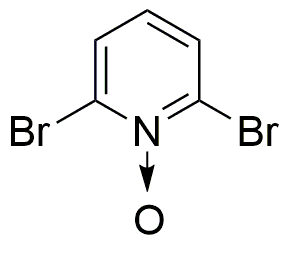2,6-Dibromopyridine N-oxide is widely utilized in research focused on:
- Synthetic Chemistry: This compound serves as a versatile building block in the synthesis of various pharmaceuticals and agrochemicals, enabling the development of new drugs and crop protection agents.
- Biological Research: It is used in studies to explore the mechanisms of action of certain enzymes and receptors, helping researchers understand biological pathways and disease mechanisms.
- Material Science: The compound is employed in the formulation of advanced materials, including polymers and coatings, enhancing properties such as durability and resistance to environmental factors.
- Analytical Chemistry: It acts as a reagent in analytical methods, aiding in the detection and quantification of other compounds, which is crucial for quality control in various industries.
- Environmental Science: This chemical is utilized in the study of environmental pollutants, helping to develop methods for remediation and understanding their impact on ecosystems.
General Information
Properties
Safety and Regulations
Applications
2,6-Dibromopyridine N-oxide is widely utilized in research focused on:
- Synthetic Chemistry: This compound serves as a versatile building block in the synthesis of various pharmaceuticals and agrochemicals, enabling the development of new drugs and crop protection agents.
- Biological Research: It is used in studies to explore the mechanisms of action of certain enzymes and receptors, helping researchers understand biological pathways and disease mechanisms.
- Material Science: The compound is employed in the formulation of advanced materials, including polymers and coatings, enhancing properties such as durability and resistance to environmental factors.
- Analytical Chemistry: It acts as a reagent in analytical methods, aiding in the detection and quantification of other compounds, which is crucial for quality control in various industries.
- Environmental Science: This chemical is utilized in the study of environmental pollutants, helping to develop methods for remediation and understanding their impact on ecosystems.
Documents
Safety Data Sheets (SDS)
The SDS provides comprehensive safety information on handling, storage, and disposal of the product.
Product Specification (PS)
The PS provides a comprehensive breakdown of the product’s properties, including chemical composition, physical state, purity, and storage requirements. It also details acceptable quality ranges and the product's intended applications.
Certificates of Analysis (COA)
Search for Certificates of Analysis (COA) by entering the products Lot Number. Lot and Batch Numbers can be found on a product’s label following the words ‘Lot’ or ‘Batch’.
Numéro de catalogue
Numéro de lot/série
Certificates Of Origin (COO)
This COO confirms the country where the product was manufactured, and also details the materials and components used in it and whether it is derived from natural, synthetic, or other specific sources. This certificate may be required for customs, trade, and regulatory compliance.
Numéro de catalogue
Numéro de lot/série
Safety Data Sheets (SDS)
The SDS provides comprehensive safety information on handling, storage, and disposal of the product.
DownloadProduct Specification (PS)
The PS provides a comprehensive breakdown of the product’s properties, including chemical composition, physical state, purity, and storage requirements. It also details acceptable quality ranges and the product's intended applications.
DownloadCertificates of Analysis (COA)
Search for Certificates of Analysis (COA) by entering the products Lot Number. Lot and Batch Numbers can be found on a product’s label following the words ‘Lot’ or ‘Batch’.
Numéro de catalogue
Numéro de lot/série
Certificates Of Origin (COO)
This COO confirms the country where the product was manufactured, and also details the materials and components used in it and whether it is derived from natural, synthetic, or other specific sources. This certificate may be required for customs, trade, and regulatory compliance.


